Eating smoky, fiery, salty and sweet pad Thai is always exciting. I have almost as much fun stir frying the noodles over a hot wok as I do taking my first bite. My favorite part about this classic Thai recipe is that everyone gets to add their own blend of additional chilis, fried shallots and sugar to truly make it their own. Ready in just 21 minutes!
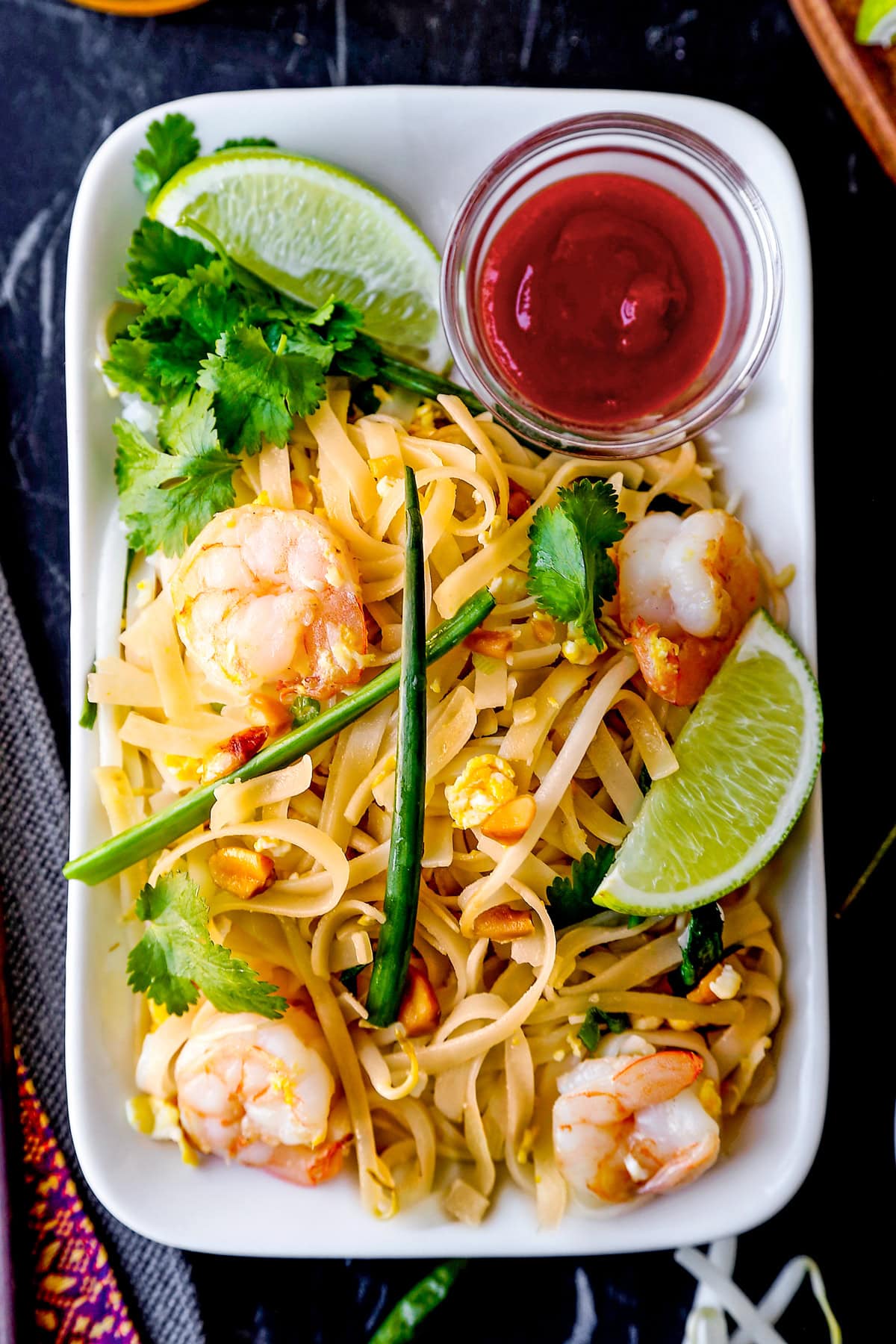
During the time I spent living and working in Bangkok, I came to a fairly obvious conclusion: the best Pad Thai was always the one I was currently eating. That same logic applied to drunken noodles and wok fried basil chicken too. But it was never more apparent than when I was digging into a plate of smoky wok fried rice noodles, flavored with fish sauce and palm sugar – topped with crushed peanuts, cilantro, dried chilies and bean sprouts. I’m powerless to the sweet, sour, spicy, salty and bitter flavors in pad Thai.
Table of Contents
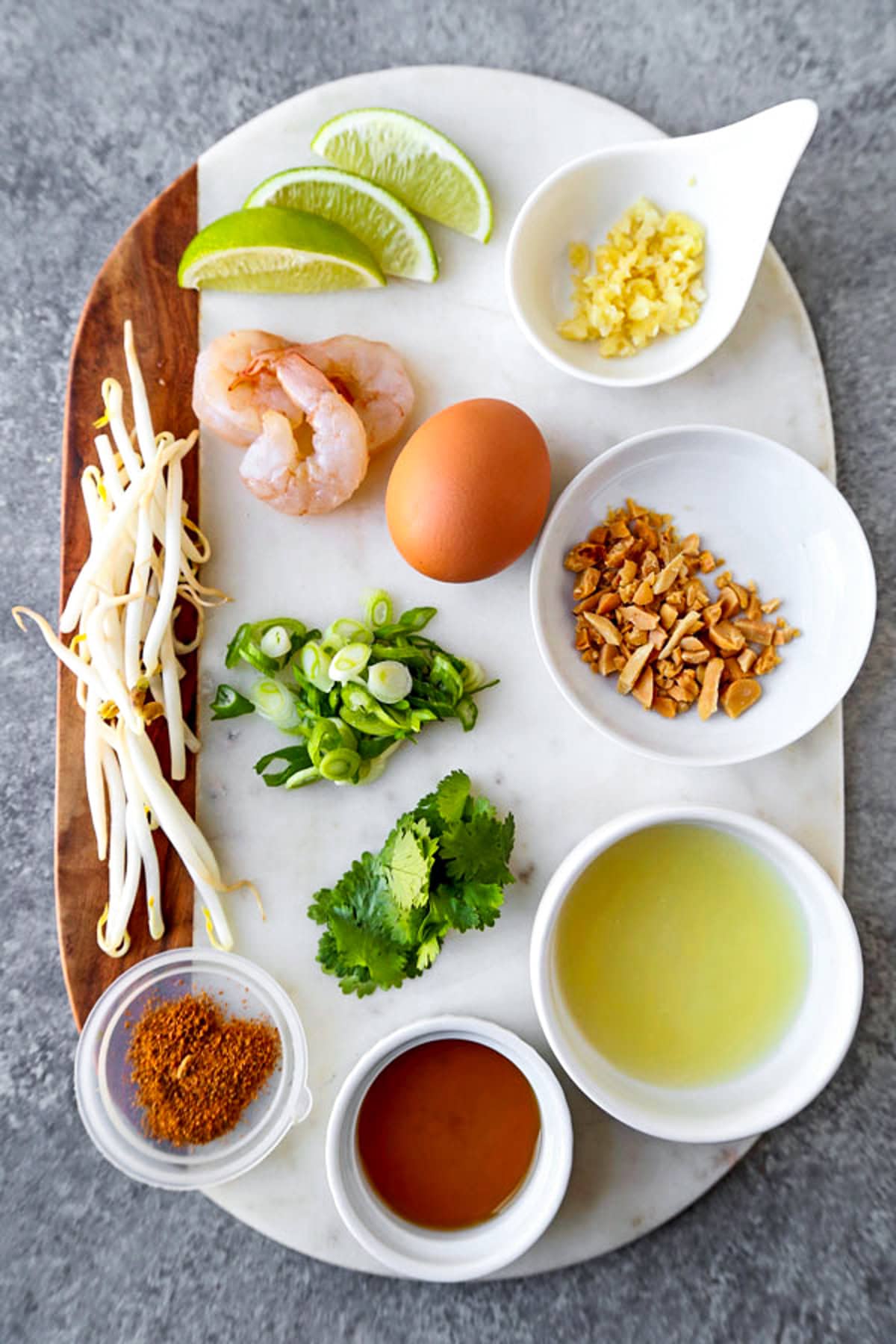
Why I Love This
My favorite part about eating pad Thai in Thailand is that I get to add condiments to make it taste exactly the way I want it to. There is usually a spice caddy on the table containing things like fiery dried chilis, dried mini shrimp, lime wedges, fried shallots, vinegar – and fresh sliced thai chilis (พริกขี้หนู, phrik khi nu) in fish sauce. Everyone dresses up their own pad Thai the way they like it best. So I modeled my own recipe on the assumption that everyone will dress their own noodles the way they see fit.
When making pad Thai, I get salty, umami tones from fish sauce, understated floral sweetness from palm sugar, and sour notes from tamarind paste. Then I use green onions and herbs like cilantro for a garden fresh bite.
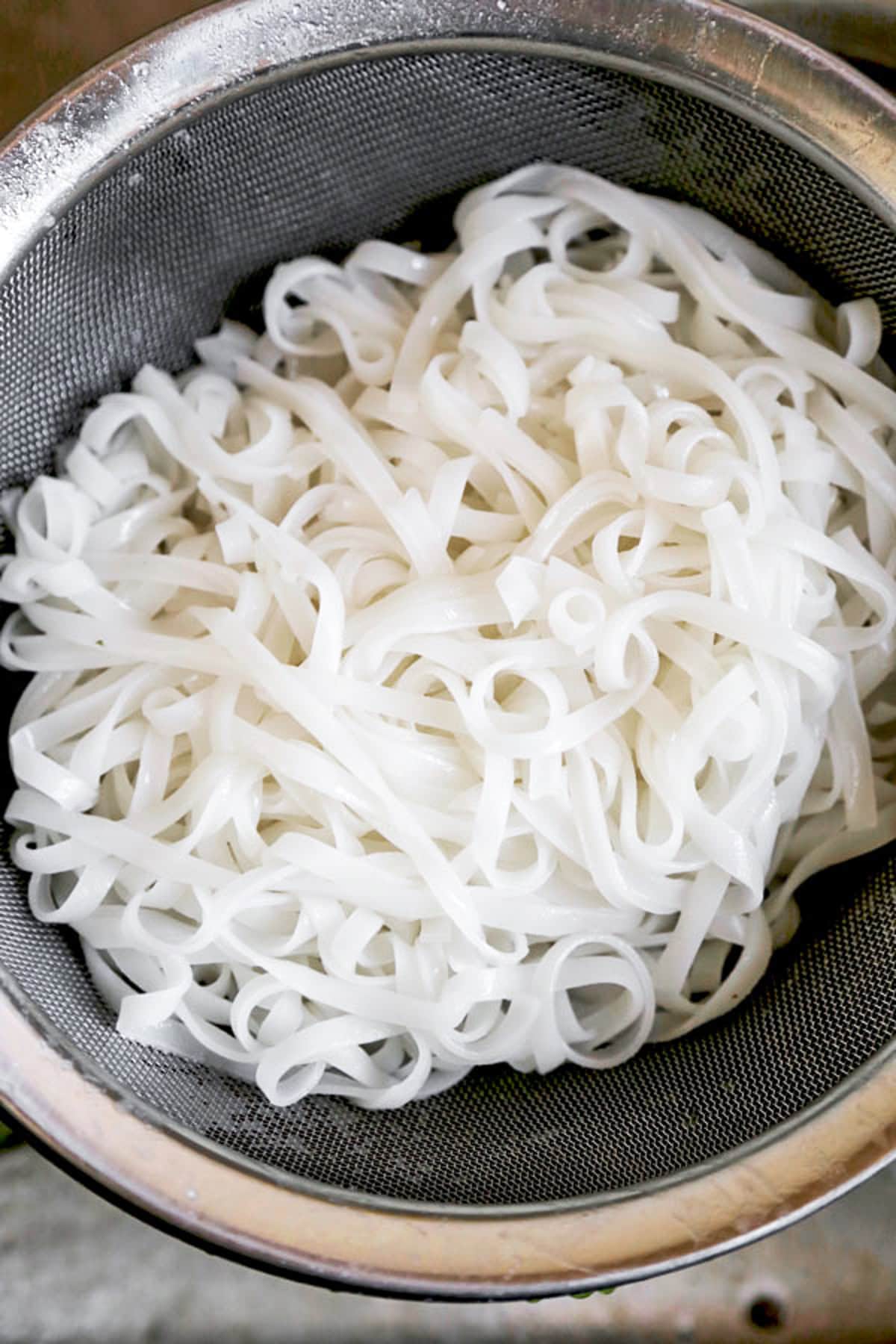
Ingredients Needed
Scroll to the bottom of this page for the full recipe steps and measurements.
- Dried Rice Noodles: These are commonly sold as rice stick noodles. I rehydrate them by soaking them in hot water.
- Cooking Oil: Any neutral flavored oil works. I use grapeseed or vegetable oil.
- Garlic: Finely chopped garlic adds amazing fragrance.
- Shrimp: Thawed, peeled and deveined. I always try to track down sustainable shrimp.
- Large Egg: I quickly scramble the egg with the shrimp, before adding the noodles, much like adding an egg to fried rice.
- Crushed Peanuts, Bean Sprouts, Cilantro and Green Onions: These provide tons of crunch, nuttiness and verdant freshness. I reserve half the bean sprouts, cilantro and scallions as a final garnish.
Pad Thai Sauce
3 Ingredients: tamarind water, palm sugar and fish sauce. I premix these ingredients and just pour them into the pan all in one go.
Why it works. Fish sauce is pretty much the table salt of Southeast Asia. It’s salty, briny, funky and perfect. Tamarind water (tamarind paste thinned with water) is sweet, sour and tangy and cuts some of the overt saltiness. Palm sugar introduces a subtle sweetness without becoming cloying.
Recipe Variations
Substitute the tamarind for lemon juice. Sure, it’s not the same. But lemon juice has a tart, sour pop that mimics the general effect of the tamarind water. And it’s much easier to track down at the corner shop.
Add fried tofu. Fried, crispy tofu is actually a very common ingredient in pad Thai in Thailand. Great for texture.
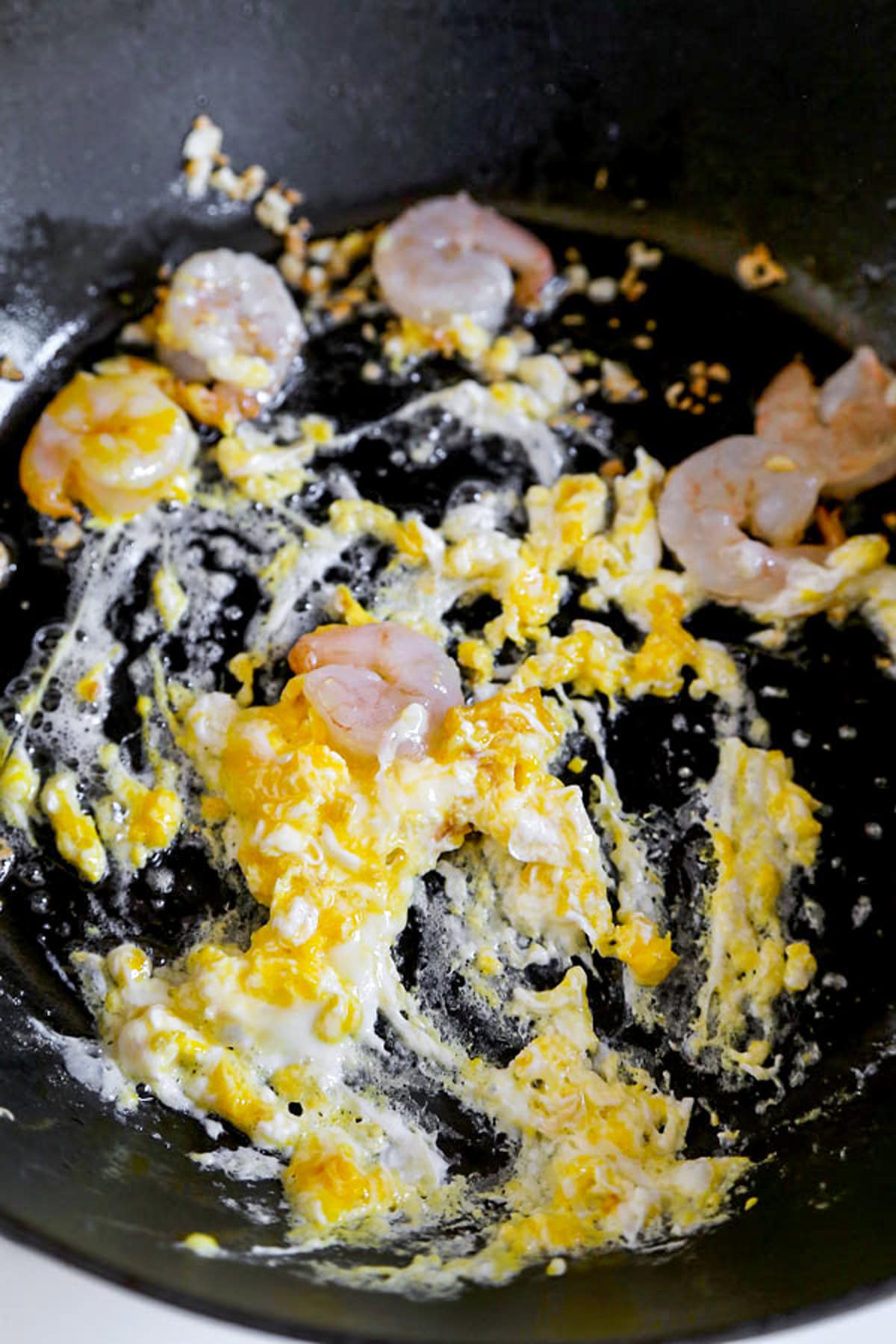
How To Make Pad Thai
- Soak the rice noodles in hot water until al dente according to the instructions on the package. Check the recipe card below for best practices. Drain and set aside.
- Stir fry the garlic and shrimp. Once the shrimp is cooked, scramble the egg.
- Add the noodles and seasoning. Mix well – and stir until the sauce has mostly soaked into the noodles.
- Add herbs and sprouts. Just stir fry half of the sprouts, green onions and cilantro. Reserve the rest.
- Garnish and serve. Top with the remaining sprouts and herbs and serve with lime wedges.
Caroline’s Expert Tips
Don’t over soak the rice noodles. I drain them when they are just shy of cooked through. Since the noodles are are finished in the pan, I keep them on the al dente side. Cooking times can differ from brand to brand. Just read the label. Preparation instructions should be on the noodle package.
Serve with plenty of condiments. That way, everyone can dress their pad Thai to their personal tastes. Common additions are dried chilis, sliced fresh chilis, sugar, crushed dried shrimp, sriracha sauce, lime wedges, fried shallots and vinegar.
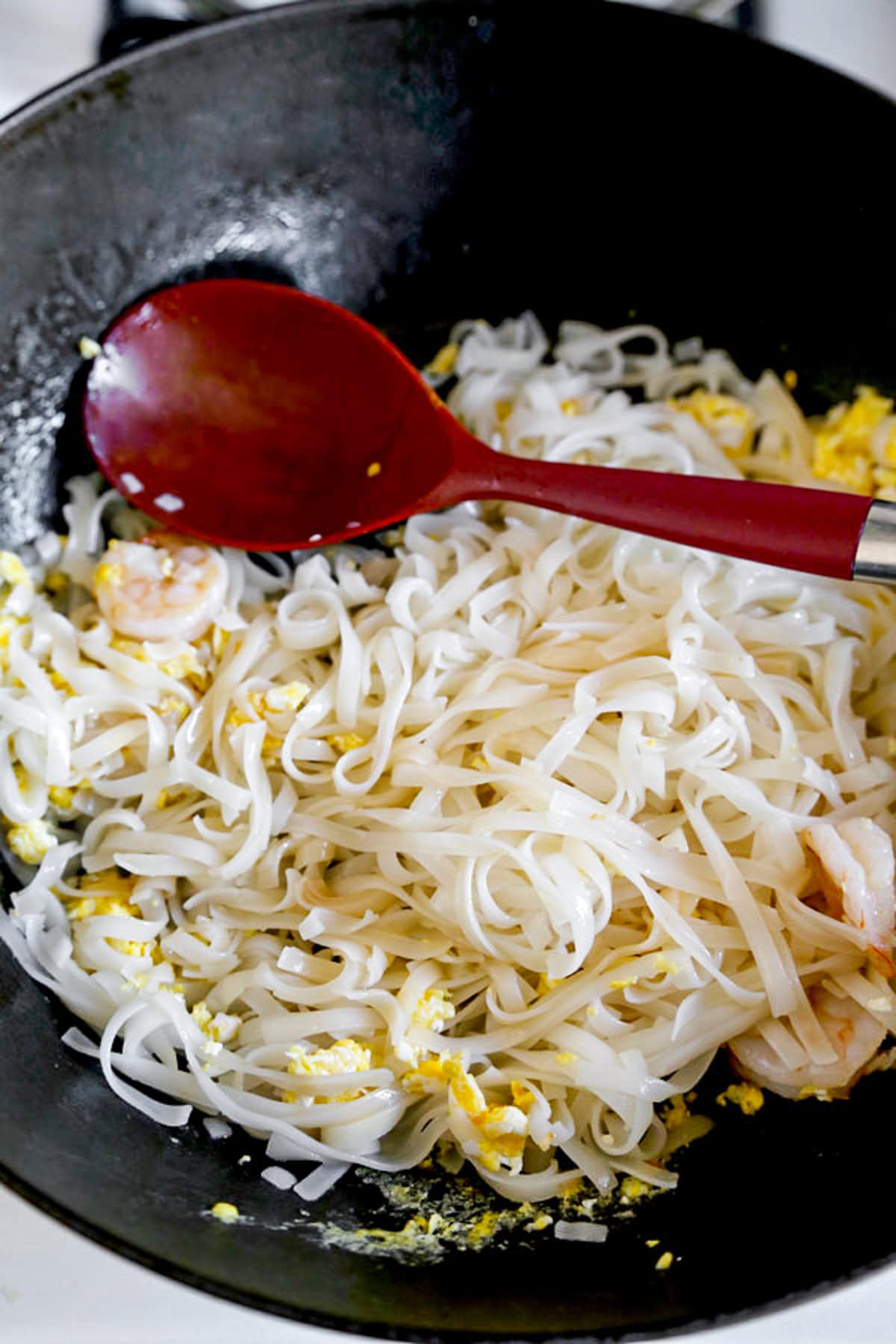
Storage and Reheating
Store leftovers covered in the refrigerator for up to 3 days. While the flavor will hold up nicely, the herbs and bean sprouts will wilt considerably.
Reheat in the microwave. Top reheated leftovers with freshly chopped green onions, bean sprouts, cilantro, crushed peanuts and a splash of fish sauce.
Since this recipe contains shrimp, I do not recommend freezing leftovers.
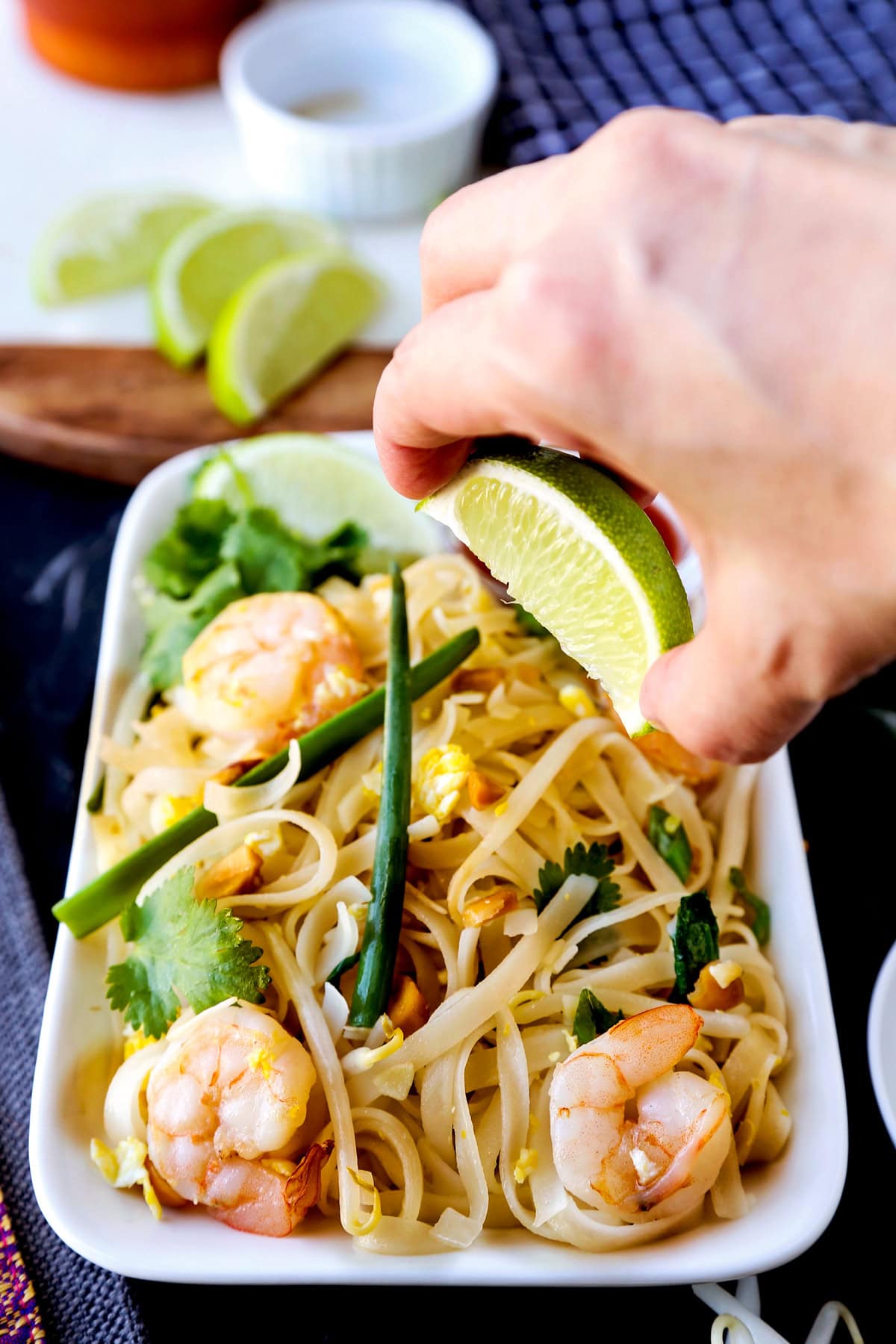
Frequently Asked Questions
If the noodles are gloppy or falling apart, they are probably overcooked. Most Thai rice stick noodles only require a quick soak in hot water to hydrate. I always follow the package instructions – and I tend to drain them before they’re fully cooked – since they’ll continue to cook in the wok.
Remember that spice caddy I mentioned from my time in Thailand? Pad Thai is meant to be augmented to each diner’s personal taste. Some people (like me) will be good with the flavors of this dish right out of the wok. My husband, the spice junky, piles on extra Thai chilis, fried shallots and fish sauce.
Yes! This recipe is gluten free as written. As always, it’s probably best for celiacs to do a quick label check on sauce bottles to make sure you don’t have anything produced in a factory that also processes wheat to avoid cross contamination.
Pad Thai is one of Thailand’s national dishes. However, Chinese traders are said to have introduced stir fried rice noodles to Ayutthaya (the former Thai capital). What followed is what always happens when a delicious food idea is introduced from abroad. It is subtly changed here and there to appeal to the taste sensibilities of the locale where it’s being served. I’d argue that, no matter the origins of pad Thai, once that delicious dish became a part of the heart and soul of the people eating it, it became a truly Thai dish.
What I Serve With Pad Thai
This is hearty enough to stand on it’s own, but when I’m making a Thai feast at home, here are some of my favorites:
- Tom Kha Soup (Thai Coconut Soup)
- Thai Green Curry
- Panang Curry
- Thai Cucumber and Shrimp Salad
- Satay With Thai Peanut Sauce
And check out these other Asian noodle recipes: pad woon sen, vegetable pad see ew, pan fried noodles with chili crisp, Singapore chow mei fun, shrimp chow mein, vegan dan dan noodles, bukkake udon, jjamppong, vegetable champon
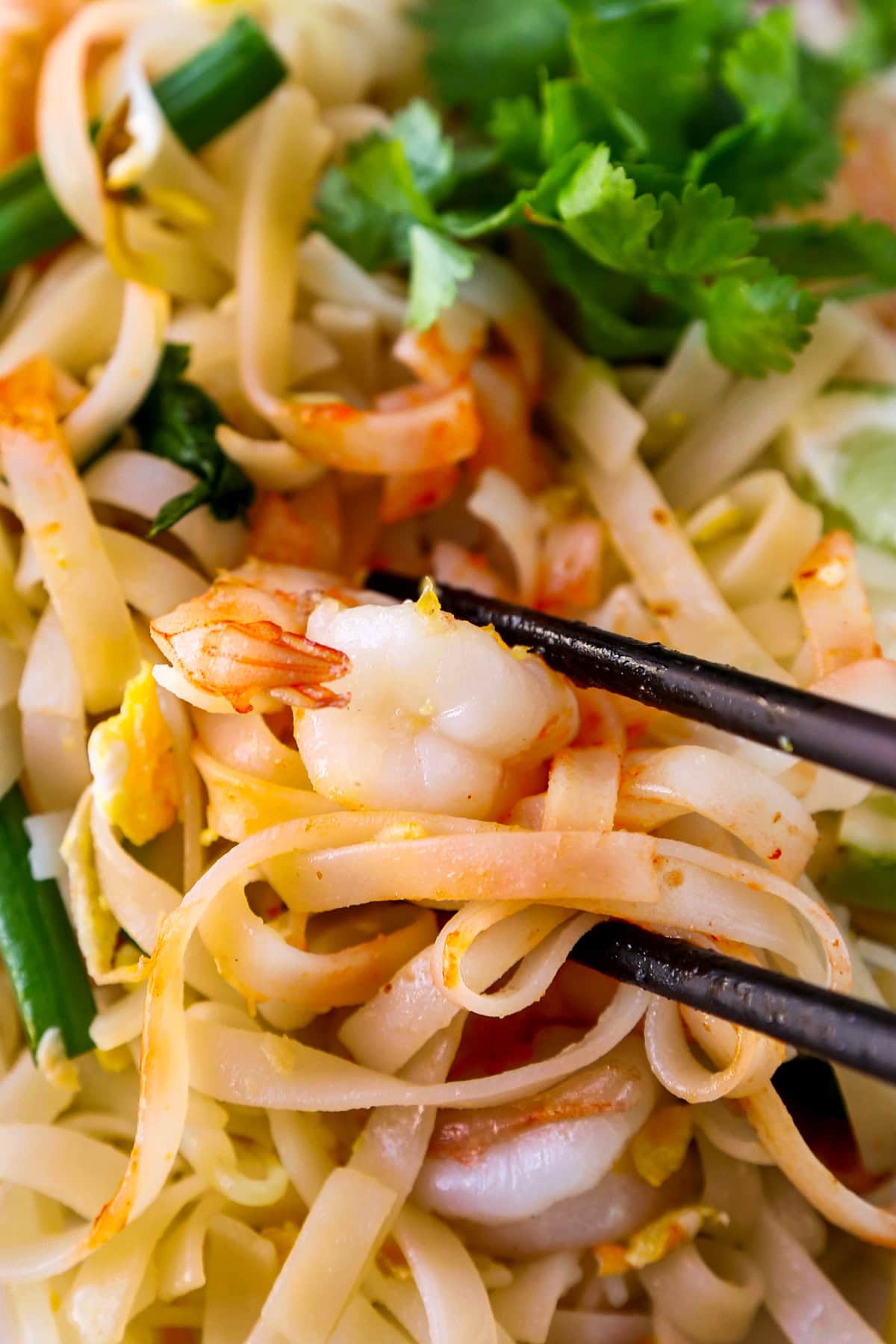
Did you like this recipe? Are there changes you made that you would like to share? Share your tips and recommendations in the comments section below!
Print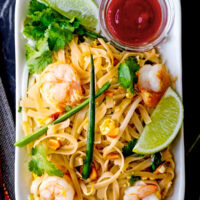
Classic Pad Thai Recipe
- Prep Time: 15 minutes
- Cook Time: 6 minutes
- Total Time: 21 minutes
- Yield: 1–2 servings 1x
- Category: Noodles
- Method: Stir Fry
- Cuisine: Thai
Description
My pad Thai is sweet, sour, spicy, salty and… well, it pretty much has all the flavors. Make it in 21 minutes from start to finish.
Ingredients
- 4 ounces dried rice noodles (pad Thai noodles)
- 2 tablespoons vegetable oil
- 1 garlic clove, minced
- 1 large egg
- 8 large shrimp, thawed, peeled and deveined
- 1 1/2 tablespoons lemon juice or 3 tablespoons tamarind water
- 2 1/2 tablespoons fish sauce
- 2 teaspoons palm sugar (optional)
- 15 peanuts, crushed
- 1 cup bean sprouts
- 2 tablespoons cilantro, chopped
- 2 green onions, chopped
- Lime wedges for serving
Instructions
- Prepare the rice noodles. Soak the rice noodles in boiling hot water until al dente. You don’t want them cooked all the way since we will be cooking them in the pan as well. Follow the instructions on the package (usually between 6-8 minutes). Drain and set aside.
- Stir fry the garlic and shrimp. In a wok or deep pan over medium-high heat, add oil and garlic. Fry garlic for 1 minute, then add add shrimp and toss them a few times.
- Scramble the egg. Push the shrimp to one side of the pan. Break the egg in the cleared side of the pan and scramble it by quickly stirring (about 20 seconds).
- Add the noodles and seasoning. Add the soaked noodles along with lemon juice, fish sauce, sugar and peanuts. Stir well and cook for 2-3 minutes – until noodles are cooked through.
- Add half of the bean sprouts, plus 1 tablespoon cilantro and half the scallions. Toss well.
- Garnish and serve. Transfer to a plate and top with remaining bean sprouts, cilantro and scallions. Serve with lime wedges and more fish sauce if needed.
Notes
After serving each diner can add their preferred amount of dried chilies, extra fish sauce, vinegar, sriracha, dried shrimp, sugar, Thai chilies, etc. Store leftovers in the refrigerator for up to 3 days.
Nutrition
- Serving Size: 1 serving
- Calories: 547
- Sugar: 9.1g
- Sodium: 1820mg
- Fat: 22.4g
- Saturated Fat: 5.8g
- Unsaturated Fat: 5.2g
- Trans Fat: 0g
- Carbohydrates: 59.6g
- Fiber: 3.2g
- Protein: 27.9g
- Cholesterol: 214.1mg

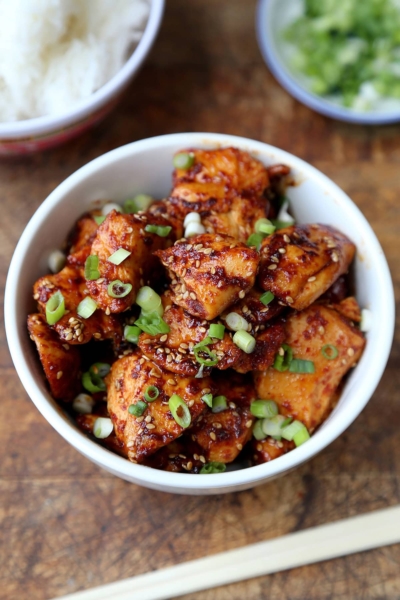
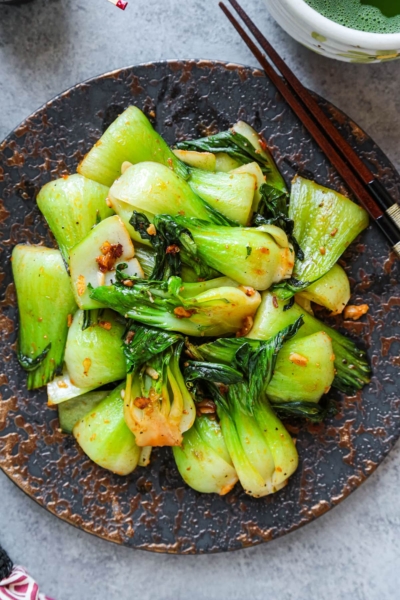
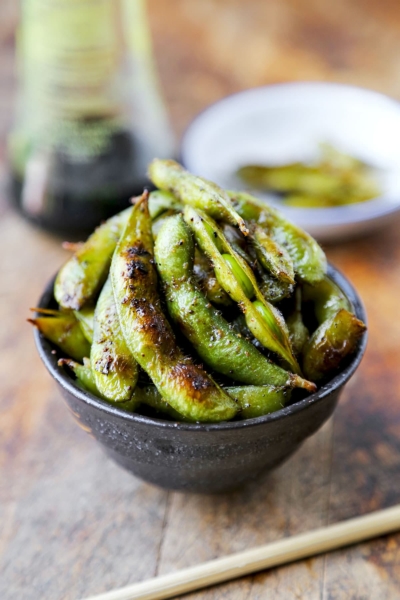
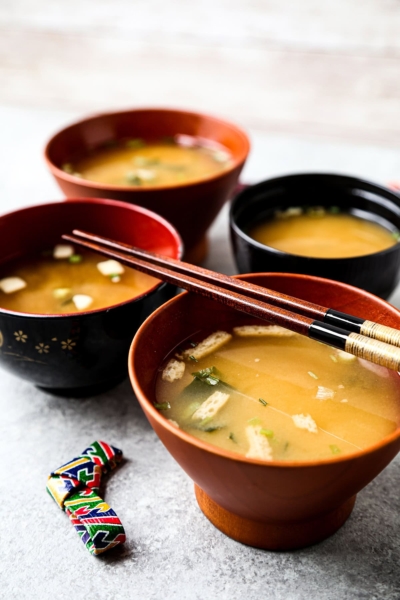
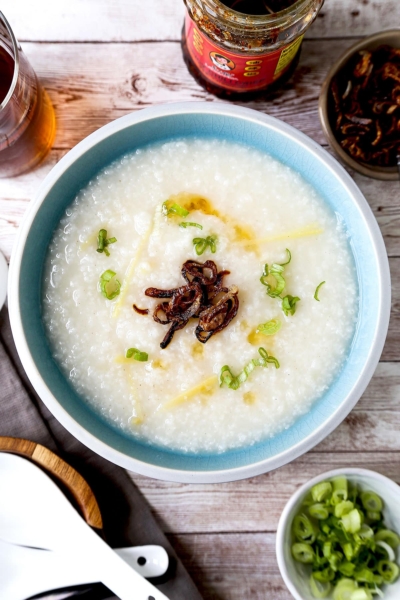
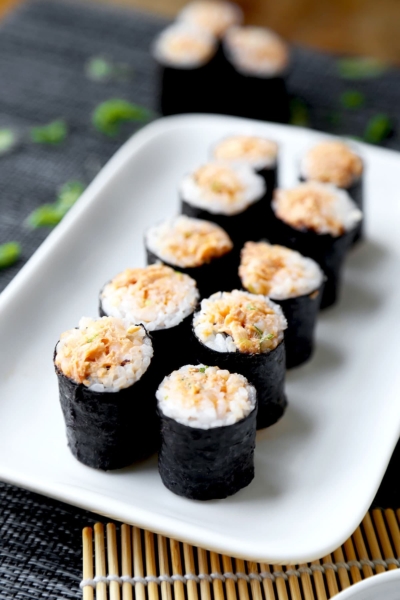








Hi Caroline, this is a very good dish and well explained. Hope you’ll find the time to pop over and add it to Carole’s Chatter’s Fooo on friday: March. Cheers
Good Asian Recipes are hard to find. Keep up the good work.
Thank you so much Darryl, I will 🙂